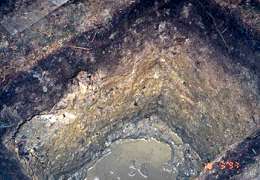Summary
Summary
Long-term monitoring of forest soils as part of a pan-European network to detect environmental change depends on an accurate determination of the mean of the soil properties at each monitoring event. Forest soil is known to be very variable spatially, however.
A study was undertaken to explore and quantify this variability at three Level II Network forest monitoring plots in Britain:
Detailed soil sampling was carried out and the data from the chemical analyses were analysed by classical statistics and geostatistics.

Soil pit at Sitka spruce (Coalburn) Level II plot
Results
An analysis of variance showed that there were no consistent effects from the sample sites in relation to the position of the trees.
The variogram analysis showed that there was spatial dependence at each site for several variables and some varied in an apparently periodic way.
An optimal sampling analysis based on the multivariate variogram for each site suggested that a bulked sample from 36 cores would reduce error to an acceptable level.
Future sampling should be designed so that it neither targets nor avoids trees and disturbed ground. This can be achieved best by using a stratified random sampling design.
Reference
Kirwan, N., Oliver, M., Moffat, A. and Morgan, G. (2005). Sampling the soil in Long-term Forest Plots: The implications of spatial variation environmental monitoring and assessment volume. 111 (1-3): 149-172.
Funding & Partners
-
 This research was funded by the Forestry Commission and the European Commission
This research was funded by the Forestry Commission and the European Commission -

